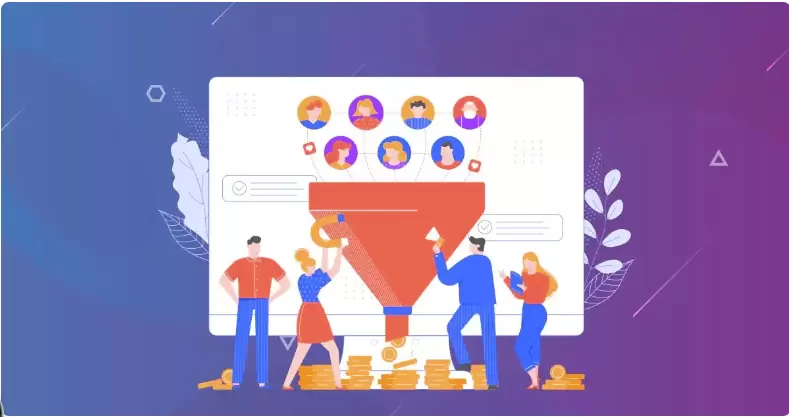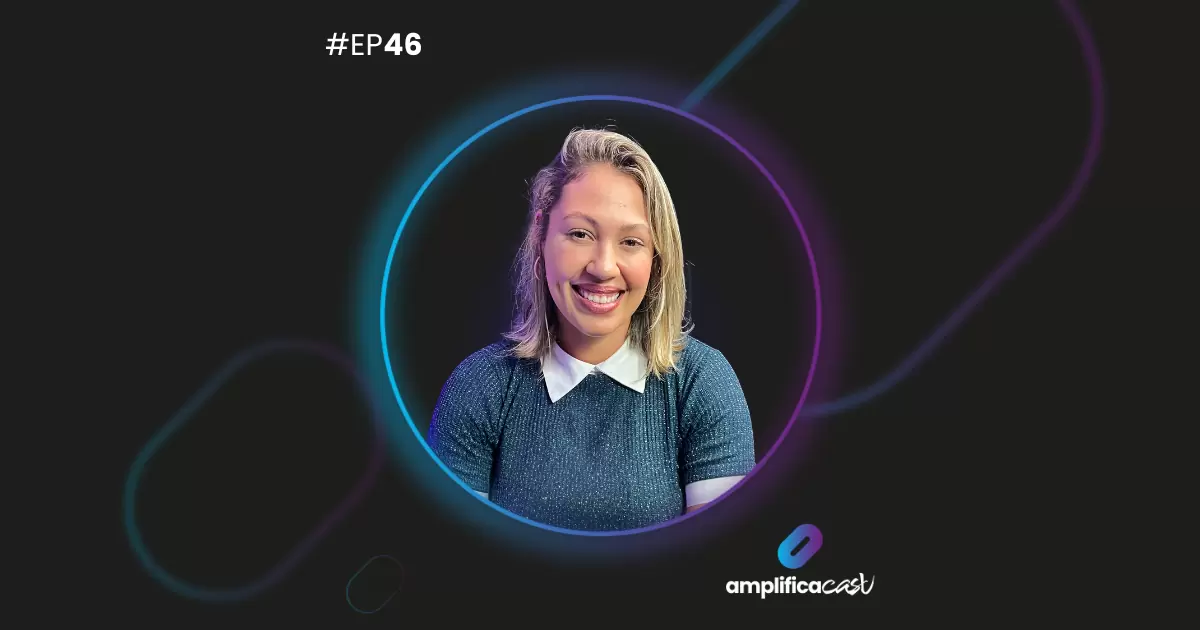The sales funnel, or marketing funnel, is a strategic model of consumption that illustrates the theoretical path that the customer must follow until making the purchase of a product or service. Thus, as in the traditional funnel, the sales funnel starts wide and decreases until it reaches real consumers. Understanding how each stage of the funnel works is essential to develop strategies that lead your contact through the sales path and is essential for the effectiveness of Inbound Marketing.
About inbound marketing download this ebook:
Top of Funnel: what is it and how to create adequate content?
The first stage of the funnel is called Top of the Funnel or ToFu (Top of the Funnel). This is the phase in which people have their first contact with your brand. This stage is the attraction to a sales possibility.
It would not be wrong to say that this moment is one of awareness, this is where you should arouse the interest of the future customer.
The consumption habit has not been the same for a long time, and companies must recreate their strategies. To that end, we have organized tips for you to deal with ToFu:
Caprice in the first contact
As we said, this phase is where people first come into contact with your company. Create an environment where consumers are curious to learn more about your brand and the solutions it offers.
Help in the moment of discovery
As soon as people discover they have a problem, they start looking for a way to solve it. Therefore, at this stage, you must create and share appropriate content to educate your audience and offer solutions to their desires.
Put the seer in you to work
Try to predict the pain points of your potential customers, this will help direct your content production. For this you need to know your target audience well, make a segmentation
But what should the content for the Top of Funnel look like?
At this stage of the funnel, your persona must absorb the idea that they have a problem to solve. Therefore, it is important that the content is easy to access and understand, since the intention is to attract the greatest number of people to then segment and qualify potential leads. Make the service you offer known, people don't know they need something they don't know about. The information must be objective, try not to put information that confuses the customer. Here’s a list of how to create content that is successful at this stage of the funnel:
- Segments your ideal audience:
- Who do you want to target?
- Which middle age of your persona?
- Why should these people consume your product / service?
- Which is genre?
- What are the ideologies?
- In which region lives?
Don't talk about your brand
People are still in the research phase, but this does not indicate that they will be interested in buying, so avoid talking directly about your researches. If in the middle of the content the user is faced with the brand name, intuitively, he will think it is pure advertising and will not give credibility to his work.
educate your persona
- All of your content should be geared toward educating your persona. It is very important to offer eBooks and infographics, so that the consumer fills out a form and becomes a lead.
- Do not restrict your content to the product or service you offer, disclose information that may be useful to your persona. Show the visitor that you have enough knowledge to write about other subjects.
- Another strategy is the use of Newsletters, because through it it will be possible to obtain e-mail addresses and communicate directly with those who have shown interest.
- After capturing the email addresses, start shooting email marketing to keep your lead always fed.
- We all have little time available, thinking about it, the video It's a great feature because they're straightforward and you don't have to stop what you're doing to watch.
- However, remember that in any format, the language at this stage must be simple and objective.
share your content
- Social networks are a great way to attract visitors of all kinds.
- Blogs are tools that will help a lot in the process of creating and sharing useful content for your persona.
- Share on as many platforms as possible, use and abuse stories on instagram, share news.
The time of the client's journey varies according to each one and does not necessarily follow a straight line. What counts for corporate success is to attract visitors who can become real customers and work consumed pathr be filled with positive experiences.
Middle of the Funnel: What is the right content?
The middle of the funnel is the moment of conversion, it is a much narrower part than the top of the funnel. But it is not yet the time for effective sales, the customer needs to be more prepared and for that, more in-depth content will be needed.
There are differences in the behavior of B2B and B2C companies. B2C companies end up investing less in the middle of the funnel, as their consumers behave differently from B2B companies, who can spend much more time in the middle of the funnel before making a purchase decision.
We remind you that the content produced at each stage of the funnel is intended to make the customer follow each stage of the consumer's path. This path builds a relationship and preparation for the sale.
At the top of the funnel, the customer discovers that he has a problem, in the middle of the funnel he looks for solutions and must be led to a product that solves his problems.
In this phase, it is necessary to create more content to keep the customer engaged, knowing that the purchase may not occur immediately.
When someone moves into your business’s funnel, it means you’ve captured their attention. The consumer has realized that he has a problem / pain that needs to be solved, and now he is looking for a solution.
At this stage you have to show that your solution is the most suitable one. It is indicated to select potential clients to apply more efforts, thus making a healthy retention of clients.
This is a point of prolonged engagement, where a relationship is built and establishing trust between the public and your brand.
When due attention is not paid to this phase, potential customers stop midway and do not hire your service.
Types of content for the middle of the funnel
Before creating any content, research your persona and discover their specificities to create personalized content.
Blog posts
The blog can also be used in the middle of the funnel. However, at this stage the content should be focused on an audience that already has knowledge on the subject. One tip is to use more details, data, information about possible pains and solutions.
E-book
For topics that are too extensive to post on blogs, the solution is to use an e-book. The advantage is that it can be downloaded in PDF format, but for that the customer needs to provide his data. This way, the nurturing process through email marketing will be easier.
Personalized newsletters
Personalized newsletters offer more in-depth content than at the top of the funnel. In addition to talking a little more about your company.
Whitepaper
A little-used format, the whitepaper is an intermediary between a post and an e-book. It's not as brief as a blog post, nor as long and in-depth as an eBook. In the case of e-Books, it is common for the user to agree to leave his contact information in exchange for the content.
Finally, pay due attention to the content created for this internship. Because the middle of the funnel phase is super important to convert leads into real buyers and maintain customer loyalty.
Bottom of funnel: how to position yourself
You piqued the user's interest at the top of the funnel, then demonstrated how your solution can help them in the middle of the funnel, now you need to know what to do at the bottom of the funnel.
Thinking that this is the final stage of sales path, it is logical to conclude that it is at this stage that your lead is ready to make a purchase, therefore, closer to becoming a customer.
As it is the final stage of the sales process, leads that reach the bottom of the funnel already understand the problem they have and certainly already know the area in which your product or service operates. At that moment, the user has already researched and compared your offer with that of other companies and now he is just thinking about the pros and cons of purchasing your product or service.
That way, your content must show that your option is the best possible. At this stage, the content should be less, but more objective.
Ask the sales team for help creating content for this lead, among the questions you will need to answer are:
- How does your service or product work?
- What is the cost x benefit?
- Why should the lead hire your service or product?
After collecting these responses, organize them in formats such as:
ebooks
An e-book can bring guides, infographics, lists and many other content formats. In addition, you can link the contents to pages on your website. E-books also help to strengthen ties with the customer in the after-sales period. Any audience loves free content, even more so when it's well done. They will have more respect for your brand.
Webinars
The direct contact provided by webinars will help to better understand the public's problems. Thus, you will be able to present your product as the best solution for it. With the right approach, you can close a lot of sales. Webinars give you the chance to show that you have authority on the subject and are convinced that you have the best product or service on the market.
customer cases
Certainly the customer cases you present will be the most convincing way to make sales. In any segment of the market, consumers are more motivated to buy when they find cases of real customers. They typically understand the problems their customers had and find out why the product or service was the best solution.
Product catalog
Offer a catalog with an organized list of products and services offered by your company. You can send this catalog through landing pages, which carry information such as photos, description and price.
Finally, when creating the content, it is essential to emphasize the values of your company. Evidence what these values are and why the product you offer is different from others.
It is bad for the company when the customer reaches this stage and gives up the purchase for lack of proper communication. Therefore, direct, simple and functional content is extremely important to retain your lead. Pass on the information that your lead wants and show that you know and believe in what you are offering.

Sales funnels: manage wisely
In some cases, it is recommended to use several sales funnels, however, it is necessary to analyze how your company behaves, what will be the demand for resources and if it really makes sense to adopt more than one funnel.
It's no secret that the bigger your business, the more products, services, and offers you'll have to deal with. In addition, the complexity of your commercial operation will also be greater, the need for organization and control. For this reason, some companies have different sales funnels.
Should I adopt multiple sales funnels?
First, the main reason for creating more than one sales funnel is to have a large volume of data and information that is dealt with in your business process. Consequently, along with this volume comes the need to keep this process organized.
However, if your business is all about a single product, or you manage a small amount of data on a monthly basis, a single funnel is sufficient for sales management.
You should only adopt multiple sales funnels when:
- Enter new products or services in the company catalog
- Your strategy is divided into many contact steps, such as pre-sales, post-sales, customer service, implementation, etc;
- Your company has several sources of demand acquisition, which bring Leads with different profiles and which will go through different processes, such as Inbound and Outbound.
In these cases, to guarantee the particularities of each process, it is necessary to adopt several sales funnels.
How will I manage multiple sales funnels on a daily basis?
There is already a tool on the market that will help in this process, the CRM.
CRM is a fundamental resource in the management of the business process. It is there that the company has the funnel in practice, in addition to monitoring the entire development of the sales process in the day-to-day of your team.
CRM enables management to be done intelligently and without wasting data or time. Thus, before deciding whether to bet on several funnels, it is necessary to choose a CRM tool that supports this operation.
That said, I can say that the management of several sales funnels follows the same precepts as commercial management in a single funnel operation. Therefore, your company needs to have a well-defined routine for each salesperson, follow-up rituals, clarity regarding metrics and goals throughout each month.
What types of sales funnel?
This is an easy question to answer, there are two types of sales funnel: Parallel and sequential
Sequential:
Os sequential funnels are those that assume continuity between sales processes. This is the case with pre-sales, sales and after-sales funnels. Leads initiate contact with the company in the first funnel, and evolve in the purchase process and pass it on. In this type of funnel, the steps are interdependent and a Lead only advances when the previous step is completed.
Parallels:
Os parallel funnels they are independent, serve different channels, products or customer profiles. This is the case of companies with more than one business unit, for example. With parallel funnels, the same customer can be negotiating in more than one funnel and close different contracts simultaneously. Parallel funnels also work for dividing commercial teams, where each team will serve a specific amount of Leads monthly.
How do I create sales funnels?
First, you will need to have the sales process for each funnel fully structured. Define what the steps will be, the tasks to be accomplished and the resources needed for each one. Second, take your funnels to CRM. Make sure that the system accepts the creation of more than one funnel, and record the defined steps and tasks. At this stage of structuring, you must define which salespeople or teams will take care of each funnel, to ensure that they only receive opportunities from the appropriate funnel.
It is extremely important that the funnels are set up correctly in CRM, so that the reports are generated with the right data and you can manage your operation properly.
I already have the funnels, what do I do now?
Your job is not over! Follow the operation closely, through daily reports and weekly meetings with the commercial teams.
Always evaluate the efficiency of each funnel, the forecast of closing deals, and look for possible bottlenecks between the steps.
Whatever the stage of the funnel, the Amplifica Digital can help you!

